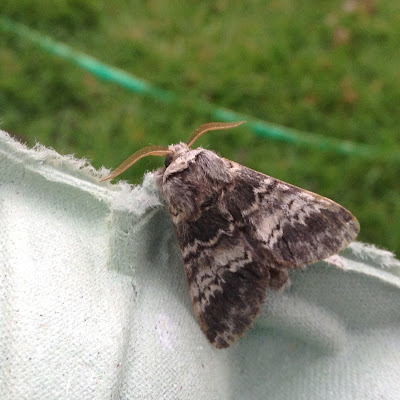I am very fond of the small but distinctive Prominent family of UK moths with their characteristic pose like a cat or dog stretching out forepaws. Here they are, above, with some useful information about eggs which I always like sharing. And, below, a bright little Brimstone moth, also the first for 2019, on the trap's cowl to welcome them.
Sunday 28 April 2019
Making a summer
I am very fond of the small but distinctive Prominent family of UK moths with their characteristic pose like a cat or dog stretching out forepaws. Here they are, above, with some useful information about eggs which I always like sharing. And, below, a bright little Brimstone moth, also the first for 2019, on the trap's cowl to welcome them.
Tuesday 23 April 2019
Good company
The warm weather has done its stuff with a clutch of excellent new arrivals including the handsome and well-antenna-ed Lunar Marble Brown above and the rather similar, fur-coaty Nut-tree Tussock below. Following the latter are the very different Pine Beauty and Waved Umber which usually start appearing here in early May, so this season continues to be an early one.
The locally common Frosted Green, a moth which never came calling in Leeds, has also made its 2019 debut with a pair arriving a fortnight earlier than previously. I guess that at any moment we will experience the nasty nips of our main entomological nuisance in this part of the world, the Blandford Fly, usually a May pest. Here's the Frosted Green below, whose name is accurate if you look closely and in certain lights; and the further North the moth is found, the greener it becomes. The patterning on the moth is variable and, as you can see, my two are slightly different in their various whorls, dots, dashes and zigzags.
 |
 |
It's seldom that moths are the only creatures in the trap. In the past, their companions have included wasps, hornets and even an angry but sadly well-fed robin. Last night saw the other creatures below: a Daddy Longlegs, two caddis flies and some sort of curious fly which a passing dipterist may one day kindly ID. All are going to be useful for the embroidered and knitted insect-themes cornice which I am currently making for the grandchildren's treehouse. Pictures will appear here in due course.
 |

 I can't resist just showing you a couple of glimpses from the wonderfully sunlit weeks which Penny and I have just had in the Lake District with our wider family (but not the moth trap; there wasn't room with all the other baggage. We took stacks of the warm/wet weather equipment usually prudent for a Lakes holiday and ending up using none of it).
I can't resist just showing you a couple of glimpses from the wonderfully sunlit weeks which Penny and I have just had in the Lake District with our wider family (but not the moth trap; there wasn't room with all the other baggage. We took stacks of the warm/wet weather equipment usually prudent for a Lakes holiday and ending up using none of it).
Finally, the excellent entomologists of Tom Bedford's family - his blog Out of the Blue Sky always makes wonderful and informative reading - have also been hatching great-grandchildren of my Emperor. His camera is much better than mine and he has kindly provided the two pictures below. I wish I could get as close to the marvellous detail of the scales. One day...
Monday 22 April 2019
Imperial births
Things have been busy in the Emperor Moth Nursery which my friends up the road have temporarily handed back to my care while they go away for an Easter break. A nice female hatched just before they left and they and I have tried our hands at Assembling - the practice of using her and her powerful pheromones as a lure for male suitors which has worked very impressively here in the past as you can see on this link here.
It may have worked this time; it usually does, because the scent mechanism is so powerful and can attract males from over a mile away. But if so, it wasn't during times when we were monitoring proceedings. First my friends tried, then I did here, then we took the moth to the other grandparents in Dorridge. On each occasion, she inspired admiration and interest from other members of our respective families, but no excited male Emperors put in an appearance. It may be that she was successfully impregnated early on, a process which ends the pheromone lure. We will never know, because she took off during her last night here. I hope that she has laid a clucth of eggs on a hawthorn nearby.
Meanwhile, a succession of cold nights kept arrivals at the light trap to a predictable minimum, Below, you can see a Hebrew Character, an Early Grey and a Powdered Quaker. In the meantime, we have been away for a wonderful week of bright sunshine in the English Lake District and the nights have become much warmer. I am now off to put the trap out for the first time in a week, with high hopes of some more interesting guests.
Friday 12 April 2019
Jack Frost
My friends up the road who are now in charge of the Emperor Moth nursery - the great-great-grandchildren of the original empress which called here in 2014 have more exciting news to pass on. They have now hatched a female - pictured below - and are hoping that she may attract some suitors to see the family onwards into its fifth generation.
Meanwhile, Penny spotted this caterpillar, below, on a walk along the canal. If anyone knows what it will hatch into, please let me know too. It spent the rest of our walk happily stretched out along the magnetic strip of an old Chiltern Railways ticket.
Thursday 4 April 2019
Spring fling
Spring has arrived in the UK and although it's the 69th I've seen - though I will remain a youthful 68 until 18 May - its pleasures still come as a pleasure and surprise. Top among them of course are the flowers which have suddenly appeared everywhere - the composite at the top le aves plenty out. It's been an additional bonus to help convert some of them into posies for Mothering Sunday (handed out along with slices of my latest superlight cream sponge cake - mouthwatering picture below).
The moth world, too, has shown how - for me at least - the seasons' passings are long enough to make me forget familiar arrivals. Maybe it's more the effect of age, but I was still delighted enough to breathe out "Nice moth!" to myself when I saw the first moth in the eggboxes below.
 It is an Early Grey, a faithful annual arrival at this time in every one of the 13 years that I've run the moth trap - and frequently the subject of a quip from me about the delicious brand of tea which we mix with ordinary leaves for the morning cuppa which I'm shortly off to make. But it's so strikingly different from the mostly brown and grey brethren in the eggboxes at the moment (as in the second picture immediately above) that, like the primroses and chionodoxas, it still gives me a start and a lift. So the season is now well under way.
It is an Early Grey, a faithful annual arrival at this time in every one of the 13 years that I've run the moth trap - and frequently the subject of a quip from me about the delicious brand of tea which we mix with ordinary leaves for the morning cuppa which I'm shortly off to make. But it's so strikingly different from the mostly brown and grey brethren in the eggboxes at the moment (as in the second picture immediately above) that, like the primroses and chionodoxas, it still gives me a start and a lift. So the season is now well under way.
The Early Grey was not the only beauty in the trap; there were also two Brindled Beauties, both males and one of them prepared to show off its beautiful antennae. Like my Earl Grey joke, my wish that human beings had these amazing organs has often been expressed here. I have occasionally attempted a little science too, trying to describe what we know about their purpose and the reasons for the wonderful variety. I'm delighted to say that this has just been done far more thoroughly and interestingly by Tom Bedford, whose family took some of my Emperor Moth caterpillars last year and both photographed and reared them with great success. You can enjoy his findings and photographs of antennae on his latest blog post here.
Finally, it is interesting to see how moths are relatively waterproof. The Hebrew Character above was asleep in its small puddle at the bottom of the trap (even Mr and Mrs Robinson's wonderful rain shield isn't 100 percent effective). It seemed unfazed and woke up in an equable mood before creeping under an eggbox to a dryer spot. More Hebrew Characters appear below, along with a Small Quaker and a Clouded Drab.
Subscribe to:
Posts (Atom)
































